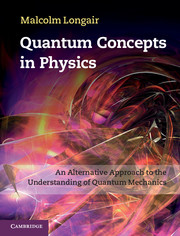Book contents
- Frontmatter
- Contents
- Preface
- Acknowledgements
- Part I The Discovery of Quanta
- Part II The Old Quantum Theory
- 4 The Bohr model of the hydrogen atom
- 5 Sommerfeld and Ehrenfest – generalising the Bohr model
- 6 Einstein coefficients, Bohr's correspondence principle and the first selection rules
- 7 Understanding atomic spectra – additional quantum numbers
- 8 Bohr's model of the periodic table and the origin of spin
- 9 The wave–particle duality
- Part III The Discovery of Quantum Mechanics
- Epilogue
- Notes
- References
- Name index
- Subject index
5 - Sommerfeld and Ehrenfest – generalising the Bohr model
from Part II - The Old Quantum Theory
Published online by Cambridge University Press: 05 February 2013
- Frontmatter
- Contents
- Preface
- Acknowledgements
- Part I The Discovery of Quanta
- Part II The Old Quantum Theory
- 4 The Bohr model of the hydrogen atom
- 5 Sommerfeld and Ehrenfest – generalising the Bohr model
- 6 Einstein coefficients, Bohr's correspondence principle and the first selection rules
- 7 Understanding atomic spectra – additional quantum numbers
- 8 Bohr's model of the periodic table and the origin of spin
- 9 The wave–particle duality
- Part III The Discovery of Quantum Mechanics
- Epilogue
- Notes
- References
- Name index
- Subject index
Summary
Bohr's success in accounting for the frequencies observed in the spectral series of hydrogen was rightly regarded as a triumph, despite the fact that it violated the classical laws of mechanics and electromagnetism. It could not account, however, for the spectra of helium and heavier elements. The Bohr model was the simplest possible model for the dynamics of a single electron in the electrostatic potential of a positively charged point nucleus, in that it involved only quantised circular orbits defined by a single quantum number n, what became known as the principal quantum number. At the 1911 Solvay Conference, before Bohr's announcement of his model for the hydrogen atom, Poincaré had raised the issue of how the quantisation conditions could be extended to systems of more than one degree of freedom. The problem was attacked by both Planck and Sommerfeld. Their approaches ended up being essentially the same, although expressed in somewhat different language. We will follow Sommerfeld's approach.
In 1891 Michelson had shown that the Hɑ and Hß lines of the Balmer series displayed very narrow splittings (Michelson, 1891, 1892). Although incompatible with Bohr's theory, the problem was set aside in the face of the other remarkable successes of the theory. Sommerfeld suspected that the explanation lay in the fact that Bohr's quantisation condition involved only a single degree of freedom. In his papers of 1915 and 1916, he extended the quantisation of the orbits of the electron to more than one degree of freedom and accounted for the splitting of the lines of the Balmer series once a special relativistic treatment of the model was adopted (Sommerfeld, 1915a,b, 1916a).
- Type
- Chapter
- Information
- Quantum Concepts in PhysicsAn Alternative Approach to the Understanding of Quantum Mechanics, pp. 90 - 118Publisher: Cambridge University PressPrint publication year: 2013



